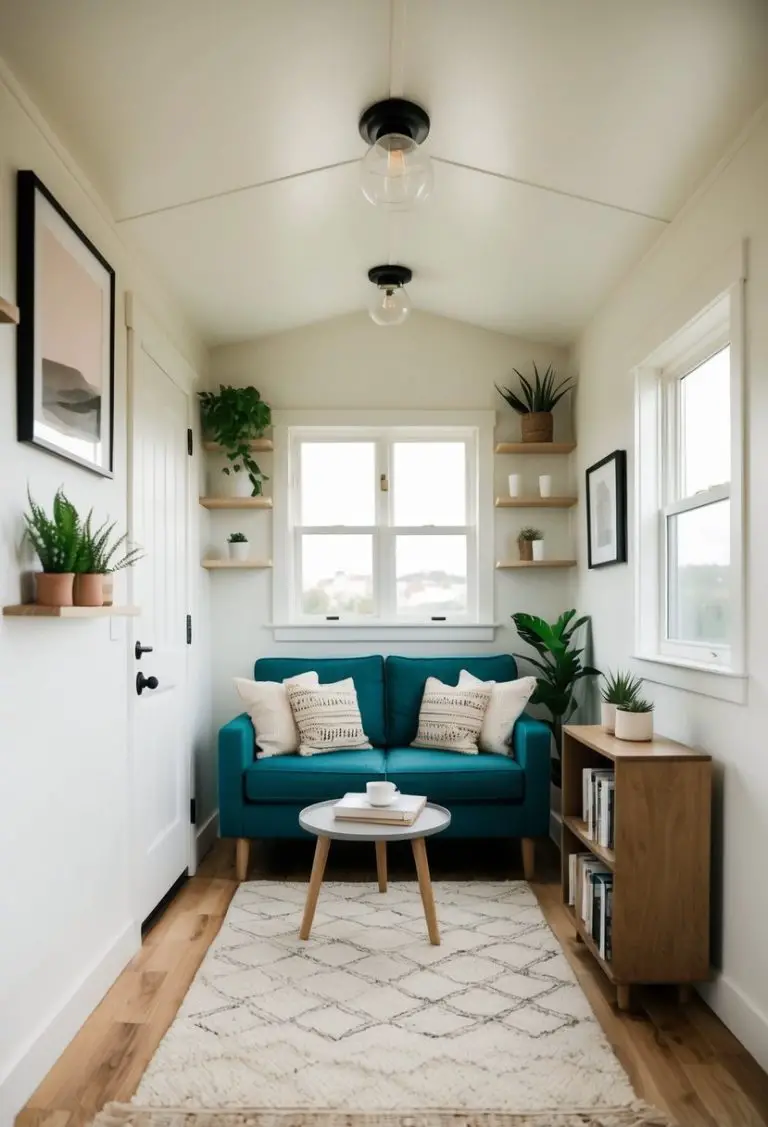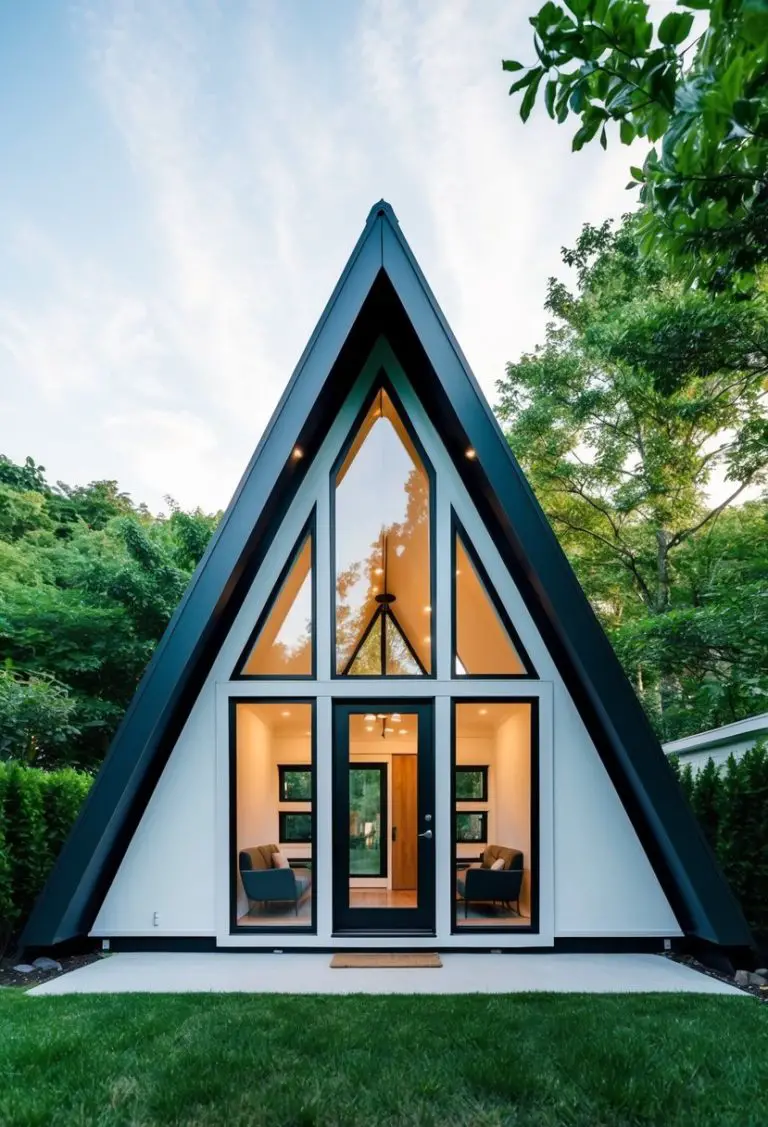Tiny House Closets Ideas: Maximize Space with Creative Storage Solutions
Closet Solutions for Tiny Homes

When designing a closet in a tiny home, it’s essential to maximize every inch of space. Start by paring down the wardrobe to include only the items that are loved and worn regularly. This helps create a more functional closet.
Incorporate drawer dividers to keep small items organized. They can be used in drawers for socks, underwear, and accessories, making it easier to find what’s needed. Hanging space is crucial as well; install adjustable or double rods to optimize vertical space for shirts and dresses.
For shoe storage, consider using vertical shelf units or under-bed boxes to keep shoes accessible but out of the way. Storage beds can also provide extra space, combining sleeping and storage solutions effectively. Finally, utilize hanging storage options, like over-the-door organizers, which can hold shoes, bags, or accessories without taking up floor space.
Ryan’s Tour of His Tiny House Closet

Ryan offers a glimpse into his unique clothing space in his tiny home, where he has lived for nearly ten years. His closet showcases a practical approach to storage, tailored to fit his personal style and daily needs.
Tiny House Closet Design

Tiny House Closet Dimensions
When designing a space for a tiny house closet, it is crucial to consider the dimensions based on the items that will be stored. The aim is to create an efficient layout that accommodates both present and future needs. To avoid running out of space, a good practice is to double the estimated volume needed.
Here are some standard dimensions for common clothing items:
| Item | Dimensions |
|---|---|
| Men’s Suit Coat | 1-1/4″ x 38″ long |
| Men’s Shirt | 1″ x 38″ long |
| Men’s Pants (Straight) | 44″ long |
| Men’s Pants (Folded) | 44″ long |
| Women’s Dress | 68″ long |
| Women’s Jacket | 36″ long |
| Women’s Blouse | 24″ long |
| Women’s Skirt | 36″ long |
| Folded Clothing | 10″ wide x 12″ deep |
| Shoes | 9″ x 12″ per pair |
Considering these dimensions will help create a closet that maximizes space in a tiny house.
Tiny House Closet Layout
The layout of a tiny house closet should reflect the storage needs of the owner. Often-used items should be placed within easy reach, while seasonal or less-used items can go on higher shelves or in drawers that require bending. A thoughtful arrangement ensures efficient use of the available space.
If someone tends to hang a lot of clothes, extra hanging rods will be beneficial. Conversely, those who prefer to fold and stack items can incorporate more shelves, drawers, and bins. Each individual’s lifestyle and clothing preferences will guide the layout.
Tips for a Functional Layout:
- Accessibility: Keep frequently used items within reach.
- Zoning: Create zones for casual and formal wear if applicable.
- Flexibility: Allow for adjustable shelves or rods to accommodate changes.
For inspiration, a design mock-up showcasing various elements — like under-bed storage for shoes or sliding doors for easy access — can be beneficial.
Items You Might Want To Store In Your Tiny House Closet
A well-planned tiny house closet can accommodate a variety of clothing and accessories. Below is a representative list of items that one might consider storing to ensure functionality and style.
- Everyday Wear: T-shirts, shorts, jeans, casual shirts
- Formal Attire: Suits, dress shirts, ties
- Seasonal Clothing: Winter coats, raincoats, sweaters
- Underwear and Sleepwear: Socks, bras, sleepwear, swimwear
- Accessories: Hats, belts, scarves, jewelry
- Footwear: Casual shoes, dress shoes, sandals, sneakers
- Outdoor Gear: Hiking boots, workout clothes, cover-ups
- Miscellaneous: Towels, purses, gloves, vests, sweatshirts, bandanas
This variety enables one to maintain a minimalist lifestyle while still having access to needed items. By carefully selecting and organizing these items, living in a tiny space can remain comfortable and efficient.
Open Shelves Vs. Cabinets In A Tiny House

Use Open Shelves For Quick Access Of Regularly Used Items
Open shelves are a practical option for storing frequently used items in a tiny house. They serve as both storage and display, allowing easy access while maintaining an attractive look. When using open shelves, it’s essential to limit the number of items, as overcrowding can create a sense of clutter.
For instance, placing open shelves above a kitchen counter can utilize vertical space effectively. One might store everyday items like dishes, jars, and small appliances here. This setup makes it convenient to grab what’s needed without digging through cabinets. Floating shelves can also be appealing for decorative purposes and serve as a place for books or plants. Multi-functional furniture can complement open shelves, providing additional storage without overwhelming the visual space.
Use Cabinets For Higher Density Storage And To Hide Disorderly Items
Cabinets offer the advantage of concealing items behind closed doors, which can help maintain a tidy appearance in a tiny home. The ability to close cabinet doors makes it easier to hide items that may not be neatly organized but are still necessary, like mail, keys, or bags.
For a small space, pull-out cabinets or drop-down bars can be smart choices, maximizing utility and keeping surfaces clear. Wardrobe-style cabinets can effectively store clothes and accessories, offering higher density storage than open shelving. This arrangement not only optimizes the use of space but also minimizes visual clutter, which can contribute to a feeling of calm.
In a cozy environment, reducing the visibility of disorderly items can lessen cognitive load, creating a more serene atmosphere. Keeping certain areas closed off allows for a balanced aesthetic, where the mind can relax without the distraction of a messy space.
Everything Has Its Place

To maintain a neat living space, it’s vital to assign a specific place for every item. This clarity helps individuals know precisely where to return things after use. Over time, this habit makes one aware of items lacking a home, signaling that they may either need a designated spot or could be candidates for decluttering.
Tips for Organization:
- Seasonal Clothing: Store off-season clothes in labeled bins to free up space.
- Minimalist Design: Embrace simplicity by keeping only essential items.
- Storage Bins: Use storage bins for easier access and organization. They help contain items while keeping areas tidy.
Creating this system aids in making a small space feel more organized and functional.
Tiny House Closet Ideas

Maximizing space in a tiny house is crucial. Here are some effective storage solutions:
- Vertical Storage: Utilize tall shelves to make the most of every inch.
- Hidden Storage: Consider under-bed drawers for discreet organization.
- Built-In Features: Custom shelves or cabinets can fit snugly in corners.
- Landing Pads: Create areas near entrances for storage of everyday items.
These smart storage solutions can enhance organization and functionality in a tiny living space.
Clever Storage Solutions for Tiny Homes

To maximize space in a tiny house, consider built-in storage options like under-bed drawers and wall cabinets. Smart storage solutions include using furniture with hidden compartments. Creative closet ideas can transform ordinary spaces into efficient storage zones. Using benches with hidden storage or slim carts can also help keep clutter at bay. Each small adjustment adds up to effective space-saving strategies.
Tiny House Closet: Loft and Storage Shelves

Efficient storage in a tiny house is crucial for making the most of available space. Thoughtful organization can help ensure everything has its place without cluttering the small area. The sleeping loft is a key part of a tiny home, and smart use of closet space and shelves can significantly enhance its functionality.
Planning for Storage
Before building, careful planning is necessary. This requires asking questions about what is really needed in the space. Identifying specific storage needs for different areas of the tiny house helps in designing a practical closet system. Taking the time to create visual aids, like sketches or models, can offer helpful insights into how the final setup will work. Creative online platforms such as Pinterest and Google Images can provide inspiration and clever storage ideas.
Creating a Model
There are various ways to create a model of the planned closet space. Options include hand sketches, software designs, or three-dimensional models made from materials like cardboard. Crafting a scaled model helps visualize the entire loft area and test if the ideas are practical. Once the plan is established and tested, it’s time to begin construction.
Designing the Closet and Shelves
The design of the closet includes identical shelves on either side. Each shelf is approximately 9 inches high, 17 inches wide, and 18 inches deep. These dimensions are ideal for fitting storage bins, which help keep items organized, especially when moving the tiny house.
In the center, two closets provide ample hanging space. Each closet measures 41 inches high, 24 inches wide, and 24 inches deep. Together, the layout offers around 37 square feet of storage, balancing both closets and shelves efficiently.
Materials used for construction include:
- Shelves: Cut from two pieces of 3/4 inch x 18 inch x 72 inch wood and one piece of 3/4 inch x 18 inch x 48 inch.
- Vertical Separators: Made from four pieces of 3/4 inch x 24 inch x 72 inch wood.
- Clothing Rod: A 48 inch long wooden dowel rod with a diameter of 1.5 inches.
- Finishing Trim: Rounded corner pine trim measuring 1 1/8 inches by 17 feet.
Adding trim around the edges not only enhances the design but also provides a polished look to the shelving.
Opportunities for Customization
While the initial setup is functional, there are ways to enhance the design. Adding a shelf above the clothes hangers, a removable shelf in each closet, or even a curtain to cover the clothing are possible improvements. These additions can be considered later, once the space is actively used and more insight into the organization is gained.
Assembly and Final Touches
Building the closet and shelves requires time, but the effort pays off in the end. It took about seven hours of work between two people to complete the assembly. The outcome not only provides helpful storage but also adds aesthetic appeal to the loft.
Smart Storage Solutions
Smart storage solutions can further improve the functionality of the tiny house. These solutions include hidden storage options, like using space under the bed for bins or incorporating multipurpose furniture. This approach allows for maximizing limited space while keeping it tidy.
Examples of Smart Storage Solutions:
- Hidden Compartments: Utilize the space under stairs or create drawers in furniture.
- Built-in Storage: Designing custom cabinetry that fits snugly in corners can help save space.
- Multi-functional Furniture: Choosing items that serve more than one purpose, such as a bed with drawers, can minimize clutter.
Space-saving Ideas
Utilizing every inch counts in tiny home living. Organizing items vertically, such as using shelving, maximizes storage. It’s important to consider how often items will be used when deciding their location. Items used frequently should be easily accessible.
Ideas for space-saving include:
- Vertical Shelving: Use tall, narrow shelves to take advantage of vertical space without using too much floor area.
- Over-the-Door Racks: These can be great for shoes or accessories, providing storage without taking up extra room.
- Hooks and Pegboards: Adding hooks or pegboards to walls can help keep items off surfaces, creating a more open feel in the loft.
In a tiny house, careful planning and thoughtful design can turn a small space into a cozy and organized home. With clever storage ideas, even challenging layouts can become practical and stylish.
5 Smart Tiny House Closet Storage Ideas

Maximizing storage in a tiny house is essential for living comfortably and keeping the space organized. Here are some effective ideas for creating efficient closet solutions.
1. Use Vertical Space
Tiny houses often have limited floor area, so using vertical space is crucial. Shelves and cabinets can be built up to the ceiling to free up important floor space. By installing high shelves, residents can store items they rarely use, while keeping everyday items within easy reach.
- Tip: Add a small step stool for access to high shelves.
2. Custom Closet Designs
Designing custom storage solutions allows homeowners to fit their specific needs and preferences. Built-in closets are an excellent way to create a seamless look while maximizing storage. Each closet can be designed to hold clothes, shoes, and accessories based on personal usage patterns.
- Dimensions: A closet with a height of about 41 inches and a width of 24 inches can hold a significant amount of clothing.
3. Hidden Storage Options
In tiny homes, hidden storage can make a big difference. Space can be used effectively by incorporating hidden compartments in furniture. For example, a bed with drawers underneath or a trunk that doubles as seating can offer additional storage without taking up extra space.
- Benefits: Hidden storage keeps items out of sight, creating a cleaner look, while also providing practical storage solutions.
4. Pull-Out Cabinets
Pull-out cabinets offer a smart design choice for tiny house kitchens and bathrooms. These narrow, sliding cabinets maximize space and can store a variety of items, from pantry goods to cleaning supplies. They are particularly useful for getting to items in tight spaces without needing to rummage through larger drawers.
- Usage: This design can be used for storing canned goods or slim jars, making it easier to find and access items.
5. Artistic Storage Display
Using shelving as a display area allows for beautiful organization of personal items. Shelves can showcase books, plants, or decorative items while also functioning as storage. This approach makes it easy to access belongings and keeps the space feeling personal and inviting.
- Suggestion: Mixing open shelves with hidden storage provides a balanced look, combining functionality with aesthetics.
When planning storage for a tiny house, it’s essential to think ahead and create a model or drawing of the space. This helps in visualizing what will work best in each area. Sketching out ideas or using software for a digital model can clarify how the closet systems will look and function.
By integrating these storage solutions, residents can achieve an organized tiny home that feels spacious and efficient. The focus should be not only on practicality but also on ensuring the closet area reflects personal style and meets the needs of daily life.
Tiny Home Organization & Closet Storage Ideas

Efficient storage is essential in a tiny home. With limited space, every inch counts, making clever organization and design key. By carefully planning storage needs, residents can create a functional and stylish living area.
Planning Storage Needs
When approaching storage in a tiny house, it begins with planning. This involves understanding what items need to be stored and where they will best fit. Questions such as “What do I use daily?” and “How can I best utilize vertical space?” can guide the thought process.
Creating a model can be helpful. This can be as simple as sketching on paper or using design software. Some might prefer making a three-dimensional cardboard model to visualize the area better. This practice allows them to see how everything fits before building.
Closet and Shelving Solutions
Closet space and shelves play a vital role in storage. Identical shelving on both sides of a loft can maximize available space. For example, a shelf could measure 9 inches high, 17 inches wide, and 18 inches deep. These dimensions work well for storage bins and keep items secure while moving. Between the shelves, closets can provide additional space. Closets that are approximately 41 inches high, 24 inches wide, and 24 inches deep offer ample room, combining to provide around 37 square feet of storage.
Choosing materials wisely adds to both functionality and aesthetics. Shelves made of finished pine can enhance the look of the space while being sturdy. Vertical separators and a clothing rod can further organize items. Adding trim can give a polished finish to the edges, making the storage area look inviting.
Smart Storage Solutions
In a tiny home, hidden and built-in storage can be innovative. Utilizing space-saving techniques helps in organizing small items without cluttering the living area. For instance, using tiered hangers in the closet can display clothing neatly while conserving space.
Another idea is to install hooks or rods above surfaces like counters, where S-hooks can hold kitchen utensils, towels, or even small bins. This elevates everyday items off the counters, enhancing both storage and accessibility.
Custom Storage Innovations
Custom storage solutions allow individuals to tailor their space according to their specific needs. Many tiny house owners find success with built-in furniture. Items like benches with storage or beds raised with compartments underneath can maximize functionality and hide away less-used items.
Creating a designated landing pad near the door is an effective organization strategy. Hooks for coats, a small shelf for keys, and a basket for shoes simplify daily routines. This keeps the entrance clutter-free and allows for easy access.
Additional Considerations
Even after the initial construction, there is always room for improvement. Adding an extra shelf above hangers can create more space for shoes or hats. Removable shelves inside closets provide flexibility for changing storage needs over time. Curtains can also be used to hide clothes, adding a charming element while keeping items organized.
Building a well-thought-out storage system may take time, but the results can significantly enhance both the look and functionality of a tiny house. Each choice, from the layout to the materials, contributes to creating an organized and efficient space. By integrating creative ideas and personal styles, tiny home residents can ensure that their living areas meet their unique requirements.
The process might involve many hours of planning and construction, but the end result is a cohesive space that feels spacious and inviting, no matter how small. Cleverly designed storage solutions not only maximize space but can also reflect the owner’s personality and needs, ultimately creating a home that is both practical and enjoyable.
DIY Ideas for Tiny Closet Storage

Making the most out of a small closet can be both fun and functional. By using creative solutions, it’s possible to maximize storage space efficiently. Here are some practical DIY ideas to optimize tiny closet storage:
Install Multi-Level Hanging Rails: Use adjustable hanging rails at varying heights to create extra space for hanging clothes. This approach allows for better organization, with tops and bottoms separated.
Utilize Shelf Dividers: Adding dividers to shelves can keep items upright, making it easier to find what is needed. This works well for folded clothes, shoes, or bags.
Use Clear Storage Bins: Clear bins help maintain visibility, allowing easy access to smaller items like accessories, socks, or underwear. Different sizes can be used to fit within the available shelving.
Under-Shelf Baskets: These can be added beneath existing shelves for extra storage. They are great for items that are used frequently but need to be kept out of sight.
Create a Door Organizer: The back of the closet door can be a valuable storage area. Installing hooks or a hanging organizer can store items like belts, ties, or jewelry.
Add a Fold-Down Table: If space allows, a small fold-down table can serve dual purposes as a surface for folding clothes and extra storage when not in use.
Incorporate Bench Seating with Storage: A seating bench with storage below provides a place to sit while putting on shoes and a hidden space for seasonal items.
By implementing these ideas, anyone can improve their tiny closet’s functionality and keep it organized.
Closet Storage Ideas for Small Spaces

Creating an efficient closet in a tiny house can maximize available space and enhance organization. Here are some practical ideas to consider:
Utilize Vertical Space: Installing shelves and cabinets that reach the ceiling can make a significant difference. This approach allows for more storage options and keeps items off the floor.
Tiered Hangers: Using tiered hangers helps save space while keeping clothing visible. This method is great for dividing outfits and allows for better organization.
Pegboards: Installing a pegboard on the inside of closet doors provides a smart way to hang accessories or smaller items. It keeps things organized and easily accessible.
Storage Bins: Clear storage bins can be stacked on shelves to store seasonal clothing or other items. Choosing bins with labels can make finding things easier.
Foldable Items: Incorporating foldable storage solutions, such as collapsible baskets or bins, allows for flexibility. These can be easily tucked away when not in use.
Add Hooks: Hooks on interior walls or doors are perfect for hanging bags, hats, or belts. They take up minimal space yet offer additional storage options.
Drawer Organizers: Using organizers in drawers helps keep small items arranged. This can include everything from socks to accessories, making it simpler to find what’s needed.
These ideas can significantly improve the functionality of tiny house closets, catering to both style and practicality.
Organizing Closets with Shelves and Drawers

When it comes to maximizing space in tiny house closets, shelves and drawers play a crucial role. They allow for better organization and easy access to various items. Here are some effective strategies:
Vertical Storage: Utilize the height of the closet by installing shelves that reach the ceiling. This offers additional storage for clothing, shoes, and other essentials.
Drawer Solutions: Incorporating drawers can keep smaller items organized. Using pull-out drawers makes it easy to find what one needs without sifting through piles.
Tiered Hangers: Employing tiered hangers can save space for clothes. These hangers allow outfits to be visible and neatly arranged.
Adjustable Shelving: Installing adjustable shelves creates versatility. They can be modified to accommodate different items as needed, from folded clothes to boxes.
Use of Dividers: Dividers can help keep clothing separated by type or season, making it quicker to find items.
Baskets and Bins: Using baskets or bins on shelves helps to contain smaller items. This method keeps everything tidy and easy to grab.
Hooks and Racks: Adding hooks inside the closet door provides extra hanging space for accessories, bags, or hats, maximizing every nook.
By combining these ideas, she can create a functional closet that meets her needs while maintaining a tidy appearance.






